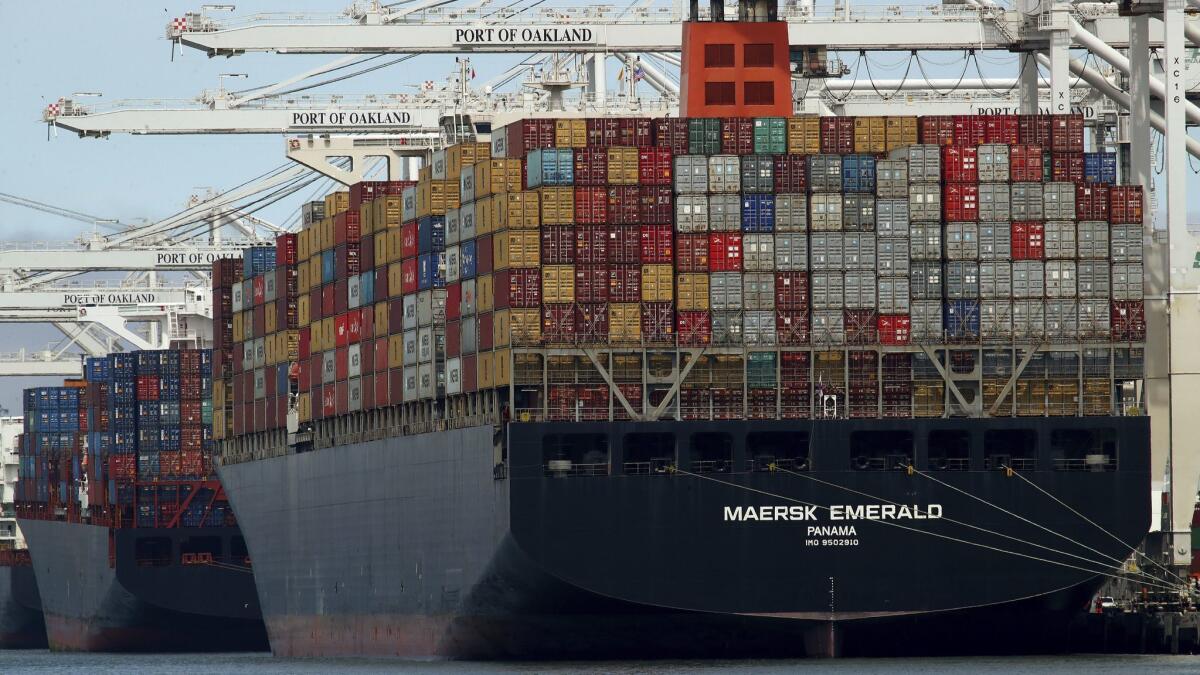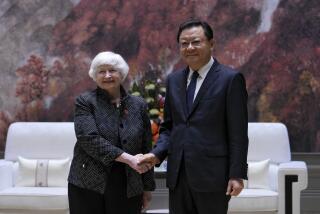As hefty new tariffs take effect, there is no sign of an end to the U.S.-China trade war

As hefty new tariffs came into effect Monday in the escalating trade war, China accused America of “trade bullyism,” intimidating other countries and adopting protectionist policies that would harm the global economy.
The largest tariffs yet — U.S. duty on $200 billion worth of Chinese goods and reciprocal Chinese tariffs on $60 billion in American products — kicked in amid fears the conflict will probably drag on at least until next year.
Global stocks took small losses on Monday, with industrial companies and banks suffering some of the worst declines among American securities.
China’s retaliation will probably see the Trump administration move ahead with an additional $267 billion in tariffs on Chinese goods. Almost half of China’s exports to the U.S. are now affected by tariffs, making them more expensive and less attractive to consumers.
On top of the trade war, military tensions have sharply exacerbated tensions between Beijing and Washington in recent days following the imposition of U.S. sanctions on China’s military for buying Russian fighter jets and a missile system. China summoned U.S. Ambassador Terry Branstad on Saturday to complain about the sanctions. It argues that its decision to buy Russian military hardware last year was an arrangement between two sovereign countries, and none of America’s business.
China released a white paper Monday, cited by the state-run New China news agency, saying that since the Trump administration’s “America First” policy came in, Washington has “abandoned fundamental norms of mutual respect and equal consultation that guide international relations.
“Rather, it has brazenly preached unilateralism, protectionism and economic hegemony, making false accusations against many countries and regions, particularly China, intimidating other countries through economic measures such as imposing tariffs, and attempting to impose its own interests on China through extreme pressure,” the news agency said.
The tariffs on $200 billion of goods, now levied at 10%, will rise to 25% by the beginning of next year unless the countries reach a deal. China’s new tariffs on U.S. goods have been set at 5% to 10%.
Earlier this year, the U.S. levied tariffs on $50 billion in Chinese goods. China retaliated by imposing tariffs on $50 billion in U.S. goods. President Trump has threatened tariffs on an additional $267 billion of Chinese goods should China retaliate today — which would mean virtually all Chinese imports to the U.S. would be affected.
The white paper, titled “Facts about the China-US trade dispute and China’s stance,” published by the State Council, said China had been “answering the U.S. concerns with the greatest level of patience and good faith. However, the U.S. side has been contradicting itself and constantly challenging China.”
The New China agency reported the aim of the white paper was to “clarify the facts,” spell out the benefits of U.S.-China trade and pose solutions to the conflict.

As well as the white paper, China also took its arguments on the trade war to the swing state of Iowa, one region hard hit by the trade war. The state-owned China Daily paid for a four-page advertising supplement in the Des Moines Register on Sunday, targeting Iowa soybean farmers hurt by China’s moves to switch to imports from Brazil and grow more of its own soybeans. The advertising supplement called the effects of the trade war the “fruit of a president’s folly.”
The main U.S. demands are long-term and fundamental policy changes, such as insisting that China behave more like a market economy rather than subsidizing key state industries, making it difficult for foreign firms to compete. It also accuses China of forcing foreign firms to transfer technological know-how to Chinese partners and of the theft of American technology.
Trade talks in recent months have not narrowed the gap between the two sides, and no resolution is expected this year. As it drags on, the trade war will probably hit the global economy. Some companies may be forced to shift production out of China, but others, such as furniture companies, will find it difficult to find manufacturers elsewhere able to produce at the scale of manufacturers based largely in southern China.
In the longer term, China will probably work harder to develop its own high-tech industries instead of relying on American components, a policy already spelled out in its “Made in China 2025” plan. The plan lays out China’s ambition to be a global leader in some high-tech industries such as artificial intelligence, robotics and superconductors.
Both sides say they are open to talks, yet neither side appears willing to budge in a significant way.
The white paper — released on a national holiday — said China was willing to talk, but that negotiations could not be held under “threats of the big stick of tariffs” or at the cost of “China’s rights to develop.” It said talks could only go ahead based on “mutual respect and equality.”
China was due to send Vice Premier Liu He to Washington this week for negotiations on a framework for trade talks, but the trip has been called off.
Narrowing the political gap may be difficult, with Chinese officials failing to offer concessions at the scale Washington wants, and Chinese President Xi Jinping probably unwilling to face domestic humiliation by backing down significantly. Xi has consolidated power since he took office as general secretary of the Communist Party of China in 2012, and a perceived defeat in the trade war would be an extraordinary setback.
Since China imports fewer goods from the U.S. than it exports, it cannot match American tariffs dollar to dollar. While the U.S. has so far imposed tariffs on $253 billion in Chinese goods, China has slapped tariffs on just $130 billion in U.S. goods, but it has vowed to match Washington’s tariffs through other means, without detailing what those would be.
They could include stepping up inspections on American goods, or creating bureaucratic barriers hampering American firms operating in China. However, Chinese leaders have ruled out manipulating the currency to make their exports more competitive.
The new U.S. tariffs affect 5,745 Chinese items, including frozen meat, fish, vegetables, chemicals, gases, handbags, clothing, furniture, fertilizers and TV components. The original list of more than 6,000 was reduced after consultations with business. Items such as smartwatches, Bluetooth devices, bicycle helmets and child safety equipment such as playpens and highchairs were excluded at the last minute.
Chinese state media have declared that the country is better placed to withstand a drawn-out trade war, but the Trump administration says it is determined to win.
“We are going to win it,” Secretary of State Michael R. Pompeo told Fox News on Sunday. “We’re going to get an outcome which forces China to behave in a way that if you want to be a power — a global power — transparency, rule of law, you don’t steal intellectual property.”
The friction between Washington and Beijing is being felt in other areas as well, including the mounting military tensions in the South China Sea, where China has built military installations on a series of islands and the United States carries out regular “Freedom of Navigation” exercises.
The U.S. has also expressed concern over reports China is holding upward of a million Muslim people, mainly of Uighur and Kazakh ethnicity, in re-education camps in Xinjiang province. A group of lawmakers led by Sen. Marco Rubio (R-Fla.) has called for sanctions on officials responsible.
Twitter: @RobynDixon_LAT
UPDATES:
3:05 p.m.: This article has been updated with stock market declining.
This article was originally posted at 10:15 a.m.
More to Read
Start your day right
Sign up for Essential California for news, features and recommendations from the L.A. Times and beyond in your inbox six days a week.
You may occasionally receive promotional content from the Los Angeles Times.






